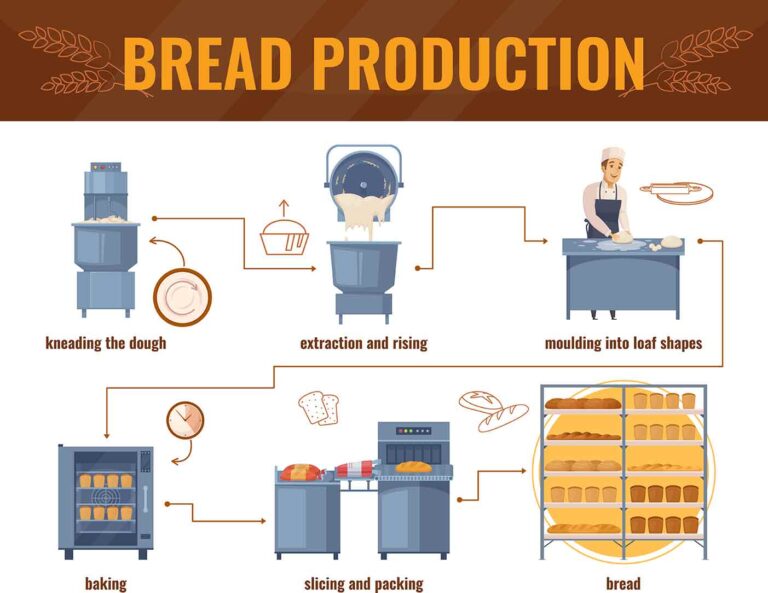- IELTS WRITING TASK 1 - PROCESS DIAGRAM
BREAD PRODUCTION PROCESS
Task: Describe the Bread Production Process
You should spend about 20 minutes on this task.
The diagram illustrates the steps involved in the production of bread, from kneading the dough to the final stages of slicing and packing. Summarize the information by selecting and reporting the main features, and make comparisons where relevant.
Write at least 150 words.
Sample Answer, C1 English Level, Advanced, Band Score 6.5-7.5
The diagram depicts how bread is made, starting from kneading the dough to the final steps of slicing and packing.
Initially, the process begins with kneading the dough, where flour, water, yeast, and other ingredients are mixed together to form a consistent mixture. After that, the dough is left to rest and rise. This is a crucial step as the yeast ferments, causing the dough to expand.
Once the dough has risen sufficiently, it is shaped into loaf forms. Skilled workers use their hands to mold the dough portions into uniform shapes, preparing them for the baking phase. These loaves are then placed into ovens for baking. The high temperatures inside the ovens transform the dough into fully baked bread, developing its characteristic texture and crust.
The final steps involve cooling, slicing, and packaging. After the bread has cooled, it is sliced into individual portions and carefully packaged for distribution and sale. This marks the end of the bread production process, resulting in the well-known food product we see in stores.
The picture shows how bread is made, going from mixing the dough to getting it ready for sale.
First, they start by mixing the dough. They combine ingredients like flour, water, and yeast to make a sticky mixture. Then, they let it sit for a while, and during this time, the dough rises because of the yeast.
After the dough rises, they shape it into loaves. This means they give it the right form for baking. Then, into the oven the loaves go! The heat in the oven bakes the bread until it’s nice and ready. After baking, they let the bread cool down. Next, they slice the bread into pieces and put those pieces into packages. Now, the bread is all set to be sold and enjoyed!
In short, making bread involves mixing the dough, letting it rise, shaping it, baking, cooling, slicing, and packaging. It’s quite a process to go from simple ingredients to the bread we see in stores!
The diagram offers an insight into the comprehensive journey of crafting bread, illustrating the meticulous process from dough preparation to the final product on the market shelves.
At the outset, the dough-making stage involves amalgamating fundamental ingredients such as flour, water, and yeast. The resultant mixture undergoes thorough kneading to achieve an optimal consistency. Following this, the dough is left to undergo a crucial phase of extraction and rising. During this interval, the yeast within the mixture initiates a fermentation process, causing the dough to swell and become more pliable.
The subsequent step entails shaping the risen dough into distinct loaf forms. This process requires skill and precision to achieve uniformity. Once molded, the dough is introduced into the baking phase, during which it undergoes a metamorphosis due to the high temperatures within the oven. The result is the golden-brown exterior and well-textured interior that characterize bread.
As a culmination of the intricate procedure, the baked loaves are cooled, sliced, and finally packaged. This meticulous approach ensures the bread is ready for distribution and consumption. In essence, the bread production process is a sophisticated orchestration of stages, transforming basic ingredients into a staple food source.


